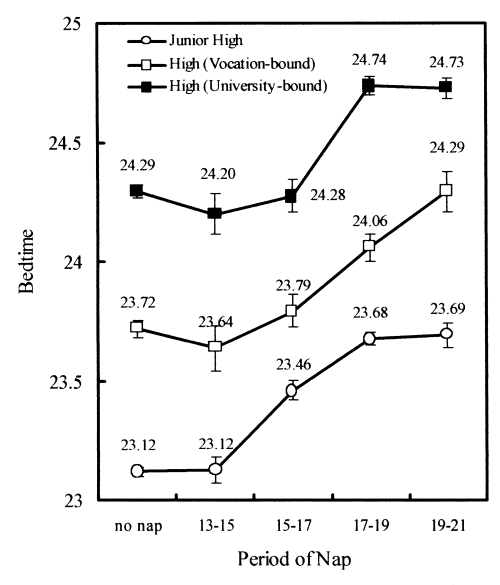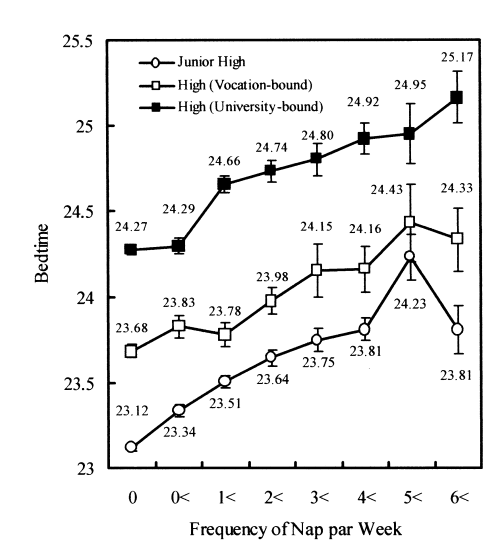Routine evening naps and night-time sleep patterns in junior high and high school students
Abstract
Abstract This study investigated the relationship between napping and night-time sleep patterns in junior high and high school students. A questionnaire concerning sleep-related lifestyle was given to about 10 000 junior high and high school students. Approximately 50% of the junior high and high school students take at least one nap per week. More than 30% of students take naps later than 17.00 hours. The late naps delayed students’ bedtime; that is, onset of night-time sleep. The bedtime of students of university-bound high schools was later than that of students of vocation-bound high schools. The more frequently students took naps, the later they went to bed. Frequent late naps delayed bedtime and, hence, shortened the length of night-time sleep.
INTRODUCTION
Fukuda et al. have administered a questionnaire to university students and adults concerning their sleep-related lifestyle.1,2 Fukuda and Ishihara have conducted a similar survey with junior high and high school students and revealed that night-time sleep length was shortest and that several physical and mental conditions were worst at high-school age.3 Some high school students take routine afternoon or evening naps to keep themselves awake to study at night at home and to compensate for their chronic sleep insufficiency. At the same time late naps are known to disturb night-time sleep. The present study investigated the relationship between napping and night-time sleep patterns in junior high and high school students.
SUBJECTS AND METHODS
Through teachers, a questionnaire concerning sleep-related lifestyle and mental health was administered to the students of junior high schools (12–15 years) and high schools (15–18 years) in Fukushima (north-east) and Okayama (west) prefectures, Japan. Approximately 10 000 students (5461 junior high school students, 4880 high school students) participated voluntarily in the survey.
RESULTS
Approximately half of the junior high school students (49.1%) and high school students (52.7%) took at least one nap per week. More than 30% of all these students took naps later than 17.00 hours (junior high 31.5%; high 35.6%). Figure 1 shows the relationship between the time of day when such students take naps and their bedtime. It is clear that the late naps delay students’ bedtime; that is, onset of night-time sleep. The bedtime of students of university-bound high schools is later than that of students attending vocation-bound high schools. Figure 2 shows the relationship between frequency of naps and bedtime. For any student group, the more frequently students took naps, the later they went to bed.

. Relationship between time of day when students take naps and their bedtime. University-bound high schools, schools at which many students enter university after graduation; vocation-bound high schools, schools at which many students start work after graduation.

. Relationship between frequency of naps and bedtime. University-bound high schools, schools at which many students enter university after graduation; vocation-bound high schools, schools at which many students start work after graduation.
DISCUSSION
The fact that students attending university-bound high schools go to bed later than students attending vocation-bound high schools suggests that home study for university entrance examinations may be a factor for delayed bedtime in this age group. Students who took frequent naps went to bed later, which strongly suggests that a custom of taking late naps probably delays the onset of night-time sleep. One may suspect that the frequent naps might be caused by an insufficient amount of night-time sleep, contrary to the aforementioned cause and effect explanation. From the results of the present study, we cannot deny the possibility that the naps have a compensatory function for the insufficient amount of night-time sleep obtained by students. A circular causal relation-ship between naps and night-time sleep might be expected; however, it might be difficult to assume the possibility that a late bedtime causes late naps. Further research is needed to clarify the functions of late naps.
ACKNOWLEDGEMENT
This research was supported by a Special Coordination Fund for Promoting Science and Technology from the Ministry of Education, Culture, Sports, Science and Technology, Japan.




